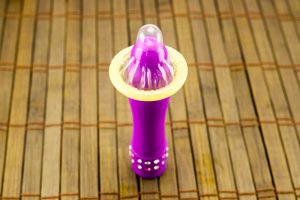In the 21st century, sexually active people are well aware that unprotected penetrative sex – anal or vaginal – can lead to a variety of sexually transmitted diseases (STD). You may not have received much sex education from school, but most health and science teachers are quick to mention sex causes diseases and babies. We don’t learn about pleasure or that sex is normal, but we learn that much.
Condoms are the most common method used to prevent STDs and the spread of disease. Whether you use them or not – and you should – you know about them. What even now is not widely discussed is the use of sex toys. Sex toys aren’t part of the sexual education discussion, and they are only now becoming a topic amongst sexually active people, in and out of relationships as the taboo of using them becomes less prevalent.
Missing in even this discussion is the conversation among partners – long-term or temporary – about how to play safe with your sex toys and avoid STDs.
Couples of all genders and sexuality have easier access to and use sex toys as part of their solo or mutual sexual experience. The potential concern for sex toy users should be in the sharing of sex toys with untested or multiple partners.
Here’s a question you may never have asked before but it’s worthy of discussion: Can you get an STD from a sex toy?
Sex Toy Use in STD Studies
 Sex toys as a transmitter of possible STDs have not been studied specifically. Instead researchers ask about the use of sex toys as part of the background research and draw correlations from that information. While some of this information should give you some comfort about the safety of sex toy usage with partners, it’s important to note that the researchers rely on the participants to be honest about their use of sex toys in sexual activity.
Sex toys as a transmitter of possible STDs have not been studied specifically. Instead researchers ask about the use of sex toys as part of the background research and draw correlations from that information. While some of this information should give you some comfort about the safety of sex toy usage with partners, it’s important to note that the researchers rely on the participants to be honest about their use of sex toys in sexual activity.
Study: Trichomonas Vaginalis
Trichomonas vaginalis (TV) is a sexually transmitted infection that shows up as a green or yellow discharge of the vulva. In a 1996 study of a lesbian couple with TV, mutual masturbation and the transmission of fluids from the women’s hands were thought to be the culprit. The study notes that the couple was asked about the use of sex toys which they denied using.
In previous but similar studies, individuals within the study were not asked. Although sex toys could not be pointed to as a possible transmitter in this study, the exchange of fluids appeared to be the reason lesbian couples in steady relationships with no outside partners contracted the infection.
Study: Hepatitis C Virus
A 2011 study looked at the prevalence of contracting the hepatitis C virus (HCV) in HIV-negative men who had sex with other men. Typically, it is more common for men who are HIV-positive to contract HCV through sexual activity. Researchers looked at how men who were negative for HIV could be diagnosed with HCV. Of the four men who participated in the study, two used sex toys at some point in their sexual history, one of whom shared them with their partner.
The study’s findings posited that the transmission of the virus was due more to rough sex that caused bleeding and mucosal damage than any other factor. While sex toys themselves may not be a transmitter, rough anal play with a toy could present a risk.
Other STD Studies
As studies of sexual behavior and health have proceeded over the years, researchers have included the use of sex toys in their studies. Two interesting studies of note found no link between sex toys and infection in their studies. A 1998 study of genital human papillomavirus (HPV) among women who have sex with women found no connection between sex toys and the virus. A more recent study, published in 2014, that studied chlamydia diagnoses in women found no statistical link between sex toy use and contraction of chlamydia although some women with sex toys did contract it.
Study: Prevention of STDs in Lesbian and Bisexual Women
Some studies aren’t necessarily about a single infection or disease, but instead focus on education and prevention of the populations affected by sexually transmitted infections. Research from 2005 looked at the perception of risk for STDs among lesbian and bisexual women. At the time, lesbians (in general) had a higher rate of bacterial vaginosis (technically an infection, not an STD) which the researchers felt may represent the potential spread of STDs based on the prevalence of the infection in lesbian and bisexual women.
They found that the women in the study took little thought or care to prevent the spread of disease and few understood the potential of STD transmission between women. The researchers found that the women often shared sex toys and engaged in penetrative sex with their toys, typically without condoms or consistent and thorough cleaning of their sex toys.
What does this mean for sex toy use and sexually transmitted infections? Education about STI transmission focuses primarily on penetrative sex and the sharing of body fluids – blood, semen, etc. While most people consider unprotected physical sexual penetration to be the only cause for concern, there is also a chance that fluids can be passed or tears created in the body through the use of sex toys.
Protecting Yourself from STDs Through Sex Toy Use
 While sex toys are often a much safer option for sexual play and penetration, precautions should still be made until you know your partner’s sexual history and whether either of you have an STD to guard against.
While sex toys are often a much safer option for sexual play and penetration, precautions should still be made until you know your partner’s sexual history and whether either of you have an STD to guard against.
It may be more common for sex toys to be used by a single person, masturbation isn’t the only way to play. Sharing a sex toy during sexual activity can be a fun and exciting way to experience pleasure. It also means that you’re sharing body fluids, potential bacteria, and any infections either you or your partner may have. Just as you should wear a condom when engaging in sexual activity before you and your partner are tested or disclose any sexual health concerns, your sex toy needs a condom as well.
Choose Your Condom Wisely
Selecting a condom for your dildo or vibrator isn’t much different than choosing a condom for a penis.
Find the right size for your condom. A condom that’s too small won’t go on or could tear. A too-big condom may fall off or be ineffective. The empty toilet paper roll method works fairly well. Slide your toy inside the tube of an empty toilet paper roll:
- If your toy fits inside a toilet paper roll with room to move, buy small condoms.
If your sex toy is a perfect fit inside, go for a medium-size condom which is the standard size. - If your vibrator or dildo doesn’t in the tube, you’ll need a large.
- Anything bigger than eight inches long or more than 2.25 inches around will need the extra-large condoms.
Choose the correct material for your toy. If you pick the wrong type of condom for the toy you’re using, you could cause damage to the toy. Condoms are inexpensive but most sex toys, especially those made of silicone, are not.
- Basic condoms with any type of lubricant are good for metal or glass sex toys.
- Silicone toys should be used with unlubricated condoms or water-based lubricated condoms.
- Do not use silicone-based lubricants or other liquids with silicone sex toys.
Use your condom wisely. Not every sex toy is designed to penetrate a body. Some are made to be penetrated. It’s important to know what to do depending on the toy you’re using.
- When the condom will penetrate your body, slide the condom on first.
- When you will penetrate the sex toy – a masturbation sleeve or Fleshlight – put the condom on your penis before using the toy.
- Put on a fresh condom between partners. If you share your sex toy during sexual play, and you penetrate your body (or the toy), apply a new condom before your partner uses it.
Cleaning and Storage of Sex Toys
 Not cleaning your sex toys properly after use, whether you share them or not, isn’t good for your toy collection. Over time, it can become too gross to use or cause damage to the toy. If you or your partner do have an STD to think about, the virus or bacteria may hang around on your sex toy. Technically STD’s can’t live too long outside the body, but it’s not a risk you should take. And dirty sex toys aren’t something you want near your vulva, anus, or penis.
Not cleaning your sex toys properly after use, whether you share them or not, isn’t good for your toy collection. Over time, it can become too gross to use or cause damage to the toy. If you or your partner do have an STD to think about, the virus or bacteria may hang around on your sex toy. Technically STD’s can’t live too long outside the body, but it’s not a risk you should take. And dirty sex toys aren’t something you want near your vulva, anus, or penis.
Soap and water is the easiest method to use to clean a sex toy. If your toy uses a battery, take them out before cleaning. For corded or USB rechargeable sex toys, make sure those areas are kept away from the water. A good, thorough scrub with special attention paid to folds, cracks, bend, or crevices in the toy will take care of any germs, bacteria, or viruses.
You can use the dishwasher or boiling water for some of your toys. Silicone, glass, stainless steel, and stone sex toys can be washed in the dishwasher or dipped in boiling water for a few minutes. This will sterilize them as well as getting rid of any dried fluids off of them. Do not put toys that have an electrical element in the dishwasher or boiling water.
For toys you can’t sterilize, use a sex toy cleaner. This is a very simple solution that can effectively clean a toy when you want more than soap and water. Spray it all over your toy, paying special attention to bends, folds, cracks, and crevices. Wipe your toy with a dry cloth. If you’re feeling extra cautious you can do this and use soap and water, too, but it’s not necessary.
A few tips to remember when you’re cleaning your sex toys:
- Antibacterial soap is unnecessary and could irritate your skin later.
- Be careful when cleaning waterproof toys. Check the instructions to find out whether they’re water-resistant or if they can be fully submerged in water.
- Remove batteries and USB cords before cleaning your toys.
- Do not put jelly, rubber, or porous toys in the dishwasher or boiling water.
- Rubbing alcohol is a good replacement for sex toy cleaner.
- Dry your sex toys with a clean cloth or towel before putting them away.
Store your sex toys properly to keep them clean. This won’t prevent the spread of STDs, but it’s a good habit to practice. Toys that are out in the open can attract dust, hair, crumbs, and other unsexy things you don’t want to put in or on your body. Use the dust bag that came with your sex toy or purchase a special bag or box to store your toys.
Conclusion
The few studies that have been conducted over the years regarding sex toys and sexually transmitted diseases have not actually focused on sex toy use as much as they have on the possibility of partners infecting one another. Because the act of transmission is fluid exchange or tears or cuts in the body that can pass bacteria or viruses, it’s safe to assume that sex toys, when shared, can play a part in the spread of disease.
When your sexual health is involved, it’s much better to be safe than sorry. Using condoms and changing them between partners can help protect everyone. Condoms also make cleaning sex toys easier as they can be discarded and the toy rinsed with soap and water when you’re done.
Regular and quick cleaning of your sex toys should not be ignored whether you’re sharing with a partner or not. Proper cleaning of your sex toys keeps you healthier and extends the life of your toy, as long as you follow the manufacturer’s instructions. Sex toys can be a wonderful way to play with a partner whether they have an STD or not, but not protecting yourself or keeping your toys clean can lead to nasty infections and other potential health problems.
Do you have questions or concerns about STDs and your sex toy? Comment below!







